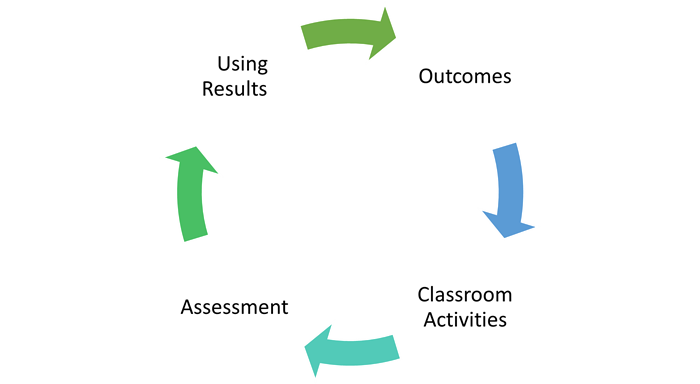Self-Assessment on Using the Results
Take the self-assessment below related to using assessment results. Content is discussed throughout Part 4.
| (1) To what degree have you participated in conversations with colleagues who teach the same course to discuss assessment plans and results? |
| (2) Why is it important to use assessment results? |
| (3) What is meant by the phrase “closing the loop” as it relates to assessment? |
| (4) In your opinion, what should happen when outcomes are achieved at the college level or in the course(s) that you teach? |
| (5) In your opinion, what should happen when outcomes are not achieved at the college level or in the course(s) that you teach? |
| (6) Name at least three questions that should be asked by a faculty member who is reviewing his/her results in comparison to college-wide results. |
It is critical to understand that assessment is not meaningful unless and until the results are used appropriately. Assessment becomes meaningful only when faculty and others review the results and use those results to inform instruction and improve learning – their own or that of their students.
Review at Palm Beach State College varies based on the type of outcomes assessed.
- Institutional learning outcomes and general education competencies – review is most often by open invitation, done in small forums, campus meetings, cluster reviews, during Development Day breakout sessions, or in committee meetings. Faculty review results and develop improvement strategies to be implemented in the next cycle.
- Program learning outcomes - annual review includes a review of learning outcomes assessment results. Program faculty review the results, select at least one outcome to target for improvement unless all have been met and other data points are selected, and develop action plans for the next cycle.
- Course learning outcomes - review is conducted individually by faculty during the annual appraisal or preparation for continuing contraction portfolio. Faculty reflections on and use of assessment results are documented and shared with associate deans.
In a conversation about using the results, it is helpful to return to the cycle that has been presented in each section of this handbook, this time thinking of it as a continuous loop (Figure 5). It truly never ends!
- We must develop outcomes, the important learning goals we set for students.
- We must ensure classroom activities will provide opportunities for students to learn what we want them to learn and achieve the outcomes.
- We must assess. How else can we know whether and to what degree they know and do what we expect them to know and do?
- Finally, we must use those results to figure out what to do next, but then it starts all over, completing yet continuing the cycle! Results may lead us to keep or revise the outcomes, but we must start all over again based on the learning goals.

Figure 6. The Teaching, Learning, and Assessment Cycle
In education, reviewing assessment results and planning for the next teaching, learning, and assessment cycle is often referred to as closing the loop. When the loop is closed on each cycle, the discussion typically includes a review of several components.
- Faculty should consider the continued appropriateness of the learning outcomes, measures, and targets, planning for improvements where needed.
- A review should include conversations about how assessments were implemented, and if that implementation still makes sense, assuming it did in the first place.
- Individual faculty should consider the results of their students and consider those results compared to students taught by colleagues.
- Together, faculty should consider ways to adjust teaching methods to address any noted learning deficiencies and ways to improve the process to ensure maximum consistency if that is a concern.
A review of the results should never be punitive! The process at PBSC continues to evolve, and so does student learning. Results should always be reported in aggregate without individual student or instructor names, and results should be used only to make learning better and to design improvement strategies. If assessment results are less than desirable, faculty should derive an improvement plan with measurable objectives without singling out any individual instructor. If a faculty member continually struggles to help students achieve a learning outcome, help is available through the Center for Teaching and Learning Excellence.28
28https://www.pbsc.edu/CTLE/